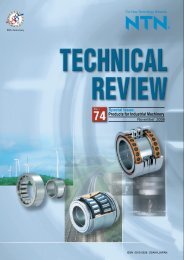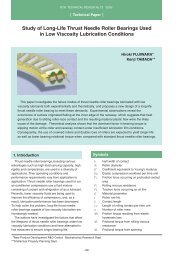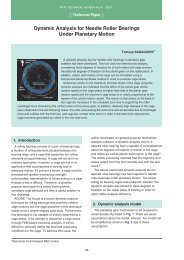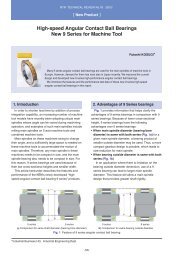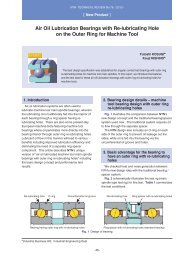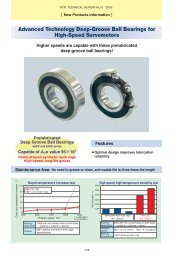[New Product] Unit Products for Office Equipment - NTN
[New Product] Unit Products for Office Equipment - NTN
[New Product] Unit Products for Office Equipment - NTN
Create successful ePaper yourself
Turn your PDF publications into a flip-book with our unique Google optimized e-Paper software.
<strong>Unit</strong> <strong>Product</strong>s <strong>for</strong> <strong>Office</strong> <strong>Equipment</strong><br />
2.2 Operating principle of lock-type torque diodes<br />
A torque diode is essentially a reverse-input<br />
blocking clutch on which rotation on the input side is<br />
transmitted to the output side, but rotation on the<br />
output side is not transmitted to the input side. If the<br />
revolution on the output side is not transferred to the<br />
input side because the output shaft is locked, then the<br />
torque diode is defined as a lock type. If the revolution<br />
on the output side is not transferred to the input side<br />
because the output shaft rotates freely, then the<br />
torque diode is defined as a free type.<br />
The operating principle of the lock-type torque diode<br />
is illustrated in Figs. 5 through 7.<br />
When the input shaft is at a standstill, the rollers are<br />
<strong>for</strong>ced by the spring to the wedge-shaped space<br />
between the inner ring cam surface, which is<br />
integrated with the output shaft, and the outer ring<br />
sliding surface. As a result, even when an attempt is<br />
made to turn the inner ring (integrated with the output<br />
shaft), the inner ring and outer ring are locked<br />
together and the inner ring does not turn (Fig. 5).<br />
The input shaft and the cage rotate together, so<br />
when the input shaft rotates, the cage also rotates in<br />
the same direction. Then, the cage comes into contact<br />
with the roller to <strong>for</strong>ce the roller toward the larger side<br />
of the cam surface (toward the spring), releasing the<br />
lock (Fig. 6).<br />
When the input shaft is further turned, the two<br />
surfaces on the input shaft come into contact with the<br />
two surfaces in the hole of the inner ring and <strong>for</strong>ce the<br />
inner ring (integrated with the output shaft) to rotate<br />
(Fig. 7).<br />
Outer ring<br />
Outer ring sliding<br />
surface<br />
Inner ring cam<br />
surface<br />
Input shaft rotates<br />
Rollers<br />
Fig. 5<br />
Fig. 6<br />
Spring<br />
Cage<br />
Inner ring<br />
(integrated with the<br />
output shaft)<br />
Input shaft<br />
Lock is released<br />
Rotation direction<br />
of the cage<br />
Rotation direction<br />
of the input shaft<br />
2.3 Structure of the TDL16 compact, lightweight<br />
torque diode<br />
The structure of the newly developed TDL16<br />
compact, lightweight torque diode is illustrated in Fig. 8.<br />
Contact point<br />
Fig. 7<br />
Housing (resin)<br />
Outer ring<br />
Roller<br />
Spring<br />
Input shaft 1)<br />
Output shaft (resin)<br />
25<br />
Cage<br />
Lid (resin)<br />
Inner ring<br />
34.8<br />
Note 1) The input shaft is not built into the torque diode.<br />
Fig. 8 Structure of TDL16<br />
-71-


![[New Product] Unit Products for Office Equipment - NTN](https://img.yumpu.com/27154451/4/500x640/new-product-unit-products-for-office-equipment-ntn.jpg)

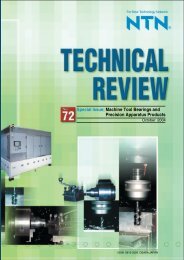
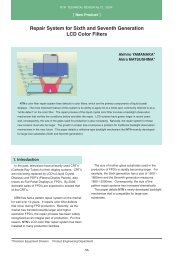
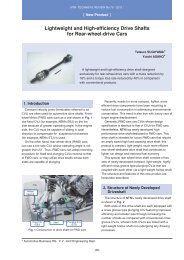
![[New Product] Development of Oil-impregnated Sintered ... - NTN](https://img.yumpu.com/27154427/1/184x260/new-product-development-of-oil-impregnated-sintered-ntn.jpg?quality=85)
